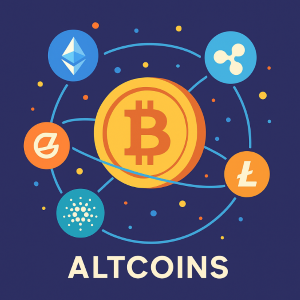What is an altcoin?

Altcoins are any cryptocurrencies other than Bitcoin. The term comes from “alternative coin,” meaning an alternative to Bitcoin.
Why did altcoins emerge?
- Expanding functionality
Bitcoin is great as digital gold, but it lacks features like smart contracts, fast payments, or private transactions. Altcoins introduce these capabilities, offering more flexibility and use cases. - Technology experiments
Developers use altcoins to test new algorithms, governance models, and mining methods — pushing innovation beyond what Bitcoin was designed to handle. - Lower fees and faster networks
Some altcoins can confirm blocks in seconds, with transaction fees that cost just fractions of a cent — making them more efficient for everyday use.
Main types of altcoins
| Type | Short description | Examples |
|---|---|---|
| Payed | Focus on fast transfers and low fees | Litecoin, Dash |
| Smart Contracts | Platforms for Decentralized Applications (dApps) | Ethereum, Solana |
| Stablecoins | Pegged to the dollar or another asset to maintain a stable price | USDT, USDC |
| DeFi-tokens | Governance of decentralized exchanges and lending platforms | UNI, AAVE |
| Meme Coins | Created for community and hype | Dogecoin, Shiba Inu |
How are altcoins different from Bitcoin?
- Algorithm. Many altcoins use alternative consensus mechanisms to validate transactions — for example, Proof-of-Stake (PoS) instead of Bitcoin’s Proof-of-Work (PoW). This often makes them faster, more scalable, and energy-efficient.
- Speed. Many altcoins generate blocks faster than Bitcoin, resulting in quicker transaction processing and confirmation times.
- Functionality. Altcoins often support features that Bitcoin doesn’t, such as smart contracts, private transactions, and on-chain project governance through tokens.
How to Buy an Altcoin
- Register on a crypto exchange. Choose a trusted platform like Binance, Bybit, OKX, or another that supports the altcoin you’re interested in. Create an account and follow the registration process.
- Fund your account with fiat or USDT
- Select a trading pair. Find the altcoin you want to buy and choose the appropriate pair — for example, ETH/USDT or SOL/USDT.
- Place an order (market or limit). Use a market order to buy instantly at the current price, or a limit order to set your own price and wait for the market to match it.
- Transfer your coins to a cold wallet if you’re holding long-term.
Risks to Keep in Mind
- High volatility. Prices can swing by tens of percent in a single day — offering big gains, but also sharp losses.
- Low trading volume. With low-cap altcoins, it’s hard to buy or sell large amounts without significantly moving the price — making them riskier and less liquid.
- Technical flaws. New or untested projects may have bugs in their code, which can lead to vulnerabilities, exploits, or loss of funds.
- Regulationю Governments around the world have varying approaches to altcoins — from support to strict bans — which can impact accessibility, legality, and market behavior.
Висновок
Altcoins represent a wide range of cryptocurrencies that offer what Bitcoin doesn’t — smart contracts, fast payments, privacy, stable pricing, and more.
If you choose to invest in them, take the time to research the project, the team behind it, and the associated risks. With the right approach, altcoins can become a valuable and exciting addition to your portfolio.
All content provided on this website (https://wildinwest.com/) -including attachments, links, or referenced materials — is for informative and entertainment purposes only and should not be considered as financial advice. Third-party materials remain the property of their respective owners.

